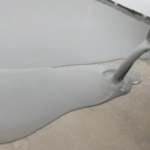What do modern boat hulls, wind turbines, aircraft wings, luxury sports cars, and space satellites have in common? It’s epoxy, a robust adhesive that is thermal, chemical, and water-resistant. It is one of the more versatile substances used in manufacturing, and any manufacturing process that uses it must factor in the curing time.
This article will cover what epoxy is, its uses, and best practices when curing it, primarily the addition of heat. As we will see, adding heat during the curing process affects the chemical bond, creating a better final product.
What is Epoxy?
We find this product in almost everything we use in our modern lives, from computer motherboards to skateboards. It is an adhesive that becomes rock hard after two substances combine. The two substances are epichlorohydrin, an epoxide, and bisphenol-A, a polyamine. Adding the polyamine to the resin base of epoxide causes a chemical reaction that hardens the mix. During the hardening process, called curing, the molecules form a crisscross pattern creating a solid bond.
Adding products called thermoplastic polymers increases the hardness and strength. There are different types of epoxies, depending on their use. During curing, the temperature, the resin, and the hardening compound affect the hardness.
What Makes Epoxy Ideal for Manufacturing?
Most industrial applications use a liquid form allowing it to flow into tight or uneven surfaces for complete coverage. One example is industrial flooring. Epoxy fills in uneven concrete floors while creating a level surface.
Other industrial applications include:
- Windmill blades
- Boats and yachts
- Skis, snowboards, and skateboards
- Aircraft and aerospace
- Automotive industry
- Abrasive drums for vegetable peeling
- Any carbon fiber applications
- Commercial, residential, and industrial building and construction
- Composites such as quartz, tile, and other decorative countertops or flooring
Epoxy offers more strength, less shrinkage, moisture resistance, and better fatigue resistance in many manufacturing processes than polyester resins. In aircraft manufacturing, it has a better heat resistance and higher compressive strength at a lower weight when compared to aluminum.
How do manufacturers get the best strength from epoxy? It has to do with the curing process.
The Best Practices for Using and Curing Epoxy
There are four steps to using and curing epoxy to get the best results.
Step 1 – Surface Preparation – The surfaces should be rough or sanded for the best adhesion. Ensure that the surfaces you want to bond are free from dust and moisture. If you plan to use a mold, line it with plastic, wax, or a release agent like PVA (polyvinyl alcohol).
Step 2 – Measure Correctly – Follow the manufacturer’s instructions for measuring each component, whether by weight or volume. Most liquid epoxies will be in a ratio of two parts epoxy to one part hardener. Inaccurate measurement will result in a mix that hardens too quickly or not hard enough.
Step 3 – Mix and Apply – The manufacturer should have a guideline for mixing time. Some epoxies need only two to three minutes, depending on the quantity. Be sure to scrape both containers clean before mixing to ensure you have the correct proportion.
Apply with a brush, roller, or pouring, depending on the usage.
Step 4 – Curing Time – There are three phases of the cure.
- Liquid or Open Time – The epoxy is liquid and workable.
- Gel – This is the initial curing phase where it hardens. It is still tacky, and you can add a second coat without further surface prep.
- Solid – The final curing phase means the epoxy has hardened. You’ll need to sand the surface before applying another layer.
The temperature has a significant effect on the curing time. The lower the temperature, the longer the curing time.
The Right Temperature for The Strongest Cure
All epoxies require either room temperature or additional heat to perform to their specified strength. Masterbond, an epoxy manufacturer, lists the cure time and temperature for their two types of epoxies.
The epoxy resin curing temperature and time for one component epoxies are:
- 60 to 75 minutes at 250°F (121°C)
- 30 to 40 minutes at 300°F (149°)
Two-component epoxies take longer to cure:
- 3-4 hours to cure at 250°F (121°C)
- 2-3 hours at 300°F (149°C)
While most epoxies will cure at room temperatures of 60°F (15.5°C) and above, elevated temperatures increase the strength and reduce curing times.
How Heat Can Help in the Curing Process
The chemical reaction during curing produces heat called an exothermic reaction. The addition of heat to epoxy during the curing process enhances its benefits, including strength, biocompatibility in medical devices, electrical conductivity, and chemical resistance.
How to Cure Epoxy with Heat
When it comes to epoxy curing time vs. temperature, even a slight increase in temperature of 20°to 30°F can reduce the curing time by 20 to 30%. Additionally, for every rise of 20°F (~10°C), the cure rate drops by as much as 20-25%.
Will Epoxy Resin Cure in Cold Weather?
There are some formulas for cold temperature epoxy that can cure in cold conditions above freezing. However, curing in cold temperatures is not as strong as curing epoxy with heat. Heating provides superior results and faster curing times.
How to Apply Heat During the Curing Process
Most industrial applications use ovens or epoxy curing blankets to cure with heat. Other heat-curing epoxy resin methods include variable-frequency microwaves (VFM), induction ovens, heat lamps, and flame guns.
Ovens are expensive and require a lot of space. Methods like heat lamps and flame guns can cause uneven heat. They also present a fire risk.
The safest and most efficient heating source for curing epoxy is with heated curing blankets. They significantly reduce the volume and cost of oven curing.
Using an Epoxy Curing Blanket Can Reduce Costs
Short curing times increase production rates. Post curing achieves greater strength, reducing parts failure and rework. A Powerblanket epoxy curing blanket saves money by decreasing the resin curing time. Blankets provide heat precisely where it’s needed, creating even heat across the surface. They eliminate the ovens’ cost and space requirements.
Powerblanket epoxy curing blankets come in 8”, 20”, and 32” widths and customized lengths to fit your needs. They can post-cure resins at temperatures up to 180° F (82.2°C) and 80 watts per square foot.
For a custom solution to cure epoxy for your manufacturing needs, contact Powerblanket.
Cure your epoxy resins faster and easier than ever before with Powerblanket.



